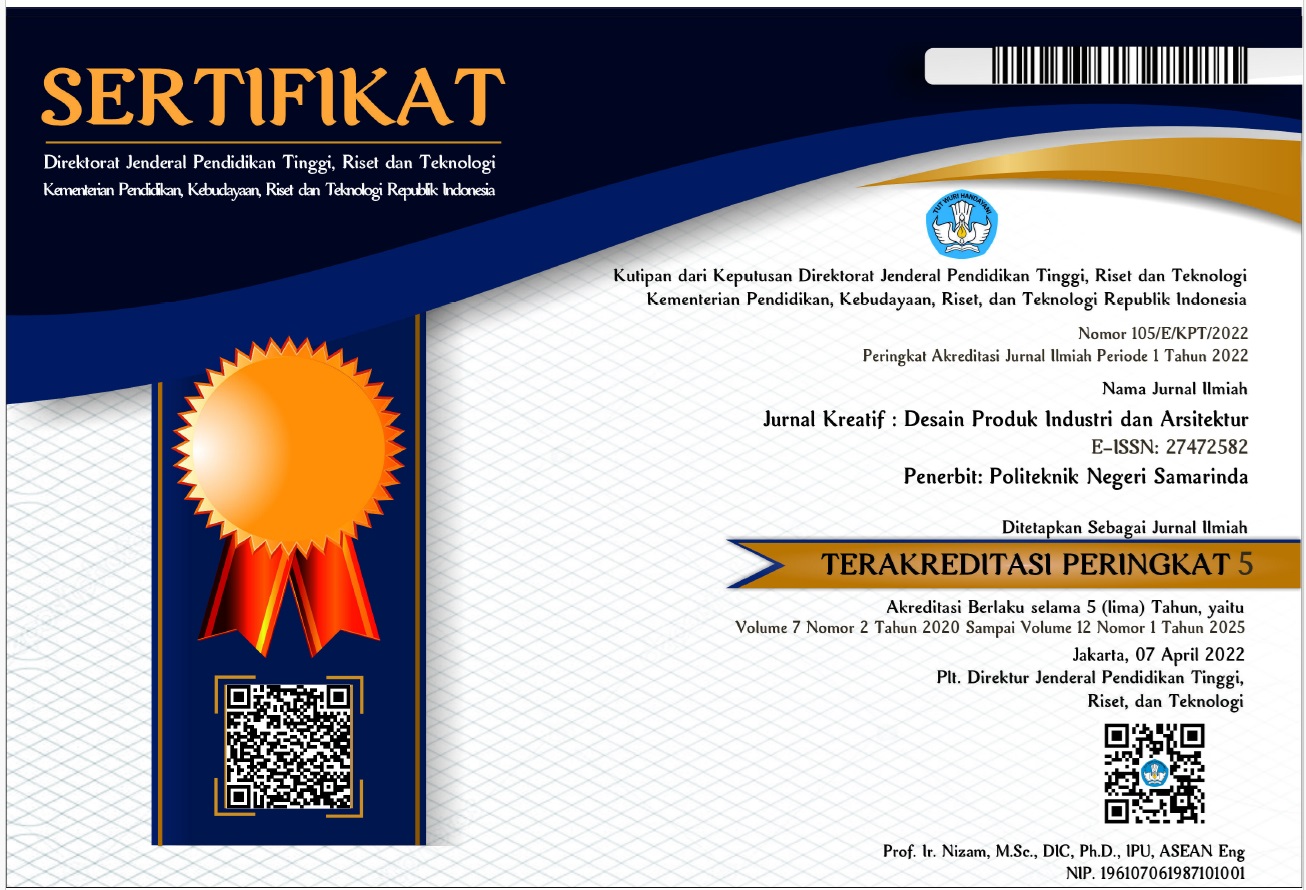DESAIN RAK BUKU BERBENTUK PEPOHONAN PINUS DARI JANGGEL JAGUNG DAN RESIN POLIMER
 Abstract views: 499
,
Abstract views: 499
,
 pdf downloads: 468
pdf downloads: 468
Abstract
Organic waste can be as an alternative to wood material on the bookcase. Corncob is an organic waste that can be used as a material to make it. By reinforcing polyester resin on corncob board composition, the bookshelves will producing to transform by pine trees. This form is taken to try to make a bookcase composed of blunt and sharp corners, where the bookshelves generally having a 900 angle.
The steps in creating a work with corncob reinforced polyester resin need to be explained and elaborated in detail. Several problems arise in the process of embodiment, among others: the technique of making the composition of corncob to be aligned board of transform by pine trees, the form of transformation is preferred to the lines, fields and textures that according to the form of pine tree/pine trees; additional construction as the reinforcement of the shape, and construction of the reinforcement to strengthen the transformer.
The design method according to Gustami method that it is three stages-six steps, which will be used to realize this product. The embodiment of corncob fields with blunt and sharp corners is used to obtain the shelves of transformation of pine trees. Some techniques of connection in wood are also used in this material, because of the resemblance of corncob material with the wooden.
This product is expected to inspire design for other furniture products. The angled shape of the board other than the elbows on the bookshelf can be used as a reference to be developed in a subsequent study, that will improve the use of corncob and polyester resin matters.
Downloads
References
Surabaya.
Arch, Izzat, 30 April 2013, Arsitektur dan Desain : Teori Transformasi, 20 Maret 2016 pukul 08.26 WIB. http://waodeizzati.blogspot.com
Gustami, SP, 2007, Butir-Butir Mutiara Estetika Timur Ide Dasar Penciptaan Seni Kriya Indonesia, Prasista, Yogyakarta.
Sanyoto, Sadjiman, Drs, Agustus 2009, Nirmana Dasar-Dasar Seni dan Desain, Jalasutra, Yogyakarta-Indonesia.
(Sony Kartika), Darsono, Juli 2007, Estetika, Rekayasa Sains, Bandung-Indonesia.
Wahmuda, Faza, 2013, Thesis Pemanfaatan Limbah Jagung sebagai Alternatif Pengembangan Produk Sederhana dalam Upaya Pengurangan Pencemaran Lingkungan, ITATS (Institut Teknologi Adhi Tama Surabaya).
Wong, Wucius, 1986, Beberapa Asas Merancang Dwimatra, ITB (Institut Teknologi Bandung), Bandung-Indonesia
Wong, Wucius, 1995, Beberapa Asas Merancang Rupa Dasar Dwimatra, ITB, Bandung.
Wangge, Anastasia Prasilia, Januari 2014, Tugas Akhir Desain Rak Berbahan Janggel Jagung, Institut Teknologi Adhi Tama, Surabaya.
Ddayipdokumen.blogspot.co.id, 25 Februari 2013, diakses September 2014
Enterpreneur, Indonesia.blogspot.co.id. (2014). Diakses 12 februari 2016 pada pukul 12.00 WIB
http://belajar.kemdikbud.go.id, diakses Nopember 2014
http://edie-juandi-pemilik-dipar-natural.html
Suryanto, Iman, Ini Cara Membuat Tas dari Bonggo Jagung, Tribunnews.com, 13 Juli 2011, diakses Nopember 2014.
Authors who publish with this journal agree to the following terms:
- Copyright on any article is retained by the author(s).
- The author grants the journal, right of first publication with the work simultaneously licensed under a Creative Commons Attribution License that allows others to share the work with an acknowledgment of the work’s authorship and initial publication in this journal.
- Authors are able to enter into separate, additional contractual arrangements for the non-exclusive distribution of the journal’s published version of the work (e.g., post it to an institutional repository or publish it in a book), with an acknowledgment of its initial publication in this journal.
- Authors are permitted and encouraged to post their work online (e.g., in institutional repositories or on their website) prior to and during the submission process, as it can lead to productive exchanges, as well as earlier and greater citation of published work.
- The article and any associated published material is distributed under the Creative Commons Attribution-ShareAlike 4.0 International License













